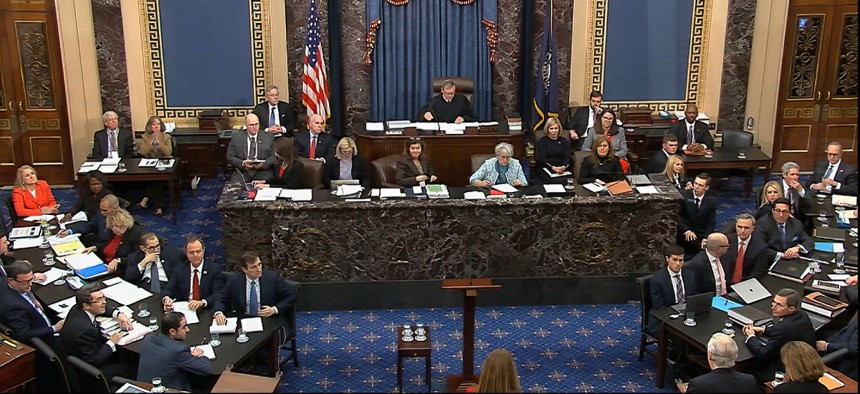C-SPAN Is So Hot Right Now

In this image from video, the Senate chamber during the impeachment trial against President Donald Trump in the Senate at the U.S. Capitol in Washington Jan. 28. Senate Television via AP
This is not a sign of a government working well.
People across America turn to it regularly. It’s getting lovingly roasted on late-night television. It’s going viral on YouTube with sizzling footage of Jerry Nadler talking two decades ago.
C-SPAN is so hot right now. And that’s a symptom of something gone deeply wrong.
The fact that so many people want to watch Congress’s activity points to just how disturbing and dysfunctional the current political era is. A perhaps surprising number of politicians are totally charisma-free, on-screen and off. Even though it’s their job to check the rest of the government and spend taxpayer money, no one necessarily wants to watch them do it hour after stultifying hour.
But C-SPAN has been watching for more than 40 years now—and judging by the growing share of its videos with 1 million or more views, its expanding subscription base on YouTube, and the hundreds of thousands who have tuned into its impeachment live-stream, a still-modest but ever larger number of Americans want in too. The United States under Donald Trump has seen an unusually high number of buzzy hearings, with James Comey versus Senate Intel becoming required viewing at bars in Washington, D.C; Michael Cohen versus House Intel streaming from countless cubicle laptops; and Robert Mueller versus House Judiciary getting obsessively analyzed for entertainment value—as if a congressional witness is supposed to scintillate. This is salutary civic engagement, maybe, but it’s not a sign that the government is working well.
Because there’s nothing entertaining about public servants doing their job properly—and when that’s what’s on C-SPAN, for most people it isn’t hot. It’s just how things are supposed to work and what citizens have a right to expect. It’s the breakdowns, the partisan rancor, the malfeasance, and the mismanagement that make for must-see TV. In normal times, a qualified ambassador’s Latin-laced testimony about foreign-aid disbursement would be of interest mainly to nerds, professionals, and professional nerds. Instead, Americans devoured Gordon Sondland’s “explosive” account of a Ukraine-aid quid pro quo.
And a network that insists on airing entire hearings in full, without the talking-head chatter and screaming chyrons of cable news, is at the center of the action. When I visited C-SPAN last week, everyone I asked about the network’s reputation for dullness seemed used to the critique—and either resigned to or fully in on the joke. The day before I caught up with him at the network’s office, Jeremy Art, C-SPAN’s social-media senior specialist, had tweeted a bit from the talk-show host Stephen Colbert about late-night impeachment arguments. (The tagline: “Indulge your impeachment fantasies with C-SPAN3 After Dark.”) I later spotted the political editor Steve Scully hunched over a desk, watching a Conan O’Brien skit from the previous night on his phone. (In it, an argyle-sweatered control-room boss amps up the C-SPAN team: “Senate impeachment trial of Donald Trump: This is our goddamn Super Bowl, okay?”)
In his office, C-SPAN’s communications director, Howard Mortman, dug up another O’Brien clip to show me, from the 1995 White House Correspondents’ Association dinner, as Nadler’s face beamed from four different screens next to him, each showing the action on the Senate floor. It’s Mortman’s favorite C-SPAN joke: “I have an announcement for those of you watching tonight’s event live on C-SPAN. For God’s sake, it’s Saturday night! Go outside, meet a woman. Come on!”
The irony of this being C-SPAN’s moment is that its cameras aren’t actually in the Senate chamber right now, and neither are any other news-media cameras. C-SPAN can and does cover every grimace and rant of House and Senate hearings—complete with speaker shots, reaction shots, witness shots, milling-about shots in committee rooms—but debates and votes on the actual floors of the House and Senate are a different matter. With rare exceptions, such as the State of the Union address, the House and Senate operate their own cameras in the chamber, with C-SPAN and other news outlets picking up the footage.
To hear C-SPANners tell it, the cinematography is lacking—and they could do it so much better. “We would love to be able to show the reactions of senators as they are listening to arguments,” Ben O’Connell, C-SPAN’s managing editor, told me. “We would’ve loved to have been able to show as each senator stood up and took their oath.” The point is not just aesthetic, but philosophical too. “We believe that it’s very important that journalists are behind the camera and deciding what people see in the room and how they see it, rather than the government,” O’Connell said.
What the millions watching can’t see is just as revealing about the process as what they can. When Representative Adam Schiff launched into the second hour of his opening arguments in Trump’s impeachment trial one day last week, you could see him taking sips of water between reflections on abuse of office, George Washington crossing the Delaware, and the wise words of Benjamin Franklin. You couldn’t see what the New York Daily News reporter Michael McAuliff spotted and tweeted about from the press gallery: 21 empty seats on the GOP side and two on the Democratic side. The Senate cameras do offer Americans the benefit of hearing the arguments on impeachment, but they give no indication about how seriously lawmakers are taking them—or by extension, their responsibility to act as jury members.
C-SPAN pushed for floor access to the impeachment proceedings, but neither Democratic leadership in the House nor Republican leadership in the Senate welcomed its cameras—even though the value of the network is a rare patch of bipartisan agreement on the Hill. (As for the impeachment hearings in the House Intelligence and Judiciary Committees last year, the network had seven cameras in place—including a tiny camera on a pole in the corner for a wide shot of each room.) C-SPAN’s appeal to the Senate, in the context of other press restrictions, prompted a New York Times headline declaring that “even C-SPAN” was “piqued.”
O’Connell would neither confirm nor deny any such state of pique, but he did say that C-SPAN journalists have requested floor access multiple times since turning on their cameras in 1979. Those efforts have pretty much always failed, with the exception of a recent documentary. For that, the Senate let them film partly from the floor, though the lawmakers had to pass a resolution to allow the cameras in. Brian Lamb, who founded the network and retired from it last year, recalled fighting in vain for floor access during Bill Clinton’s impeachment too. “We were running down a blind alley into a dead end,” he told me.
Politicians “really don’t understand television,” Lamb added, lamenting their need to control how they’re seen. “They understand that it can damage them.”
And it has. When he was House speaker in the 1990s, Newt Gingrich also refused to let C-SPAN cameras onto the floor, though he did let House camera operators experiment with reaction shots, according to Chad Pergram, a Fox News congressional correspondent who previously worked at C-SPAN. “That experiment lasted about a week as the House feed showed lawmakers dozing, goofing off and reading,” Pergram wrote in a column for Fox News. “Callers then lit up the Capitol switchboard as they phoned to admonish their lawmakers for not showing respect to the speaker or accusing them of sloughing off on the taxpayer's dime.” (Gingrich then backed off to let them do so in private.)
One can almost sympathize with their anxiety. Politicians work for the public, and who wants their boss watching them all the time? But if you’re the boss, you presumably want to know that the person whose salary you pay is, say, following company policy and showing up to meetings. That’s especially important right now, when those very employees keep saying that the fate of the entire country is at stake in their deliberations.
A properly functioning government is one that the average citizen has the luxury to ignore rather than think about, much less spend hours watching tear itself apart. But the government isn’t functioning properly these days—in ways that long precede Trump and impeachment—and the extent of its failures should actually make C-SPAN even hotter than it is right now. Mortman said that well before The Washington Post’s Afghanistan Papers series exposed how officials kept expressing optimism about the war in public while panning it in private, C-SPAN had aired hundreds of hearings on the matter, dating back to 2001, in which much of the series’ revelations could have been gleaned. From fiscal mismanagement to bungled wars, politicians aren’t succeeding enough anymore to give Americans the luxury of boredom. And they’ve been failing in plain sight, in front of the cameras. Americans may be tuning in too late.






